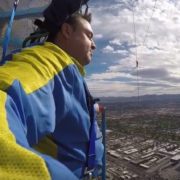Me, my scared self and I: The lessons I learned from my fear of heights
Why would someone with a serious fear of heights attempt two of the world’s scariest challenges? For entrepreneur Graeme Carling, tackling both wasn’t so much a test of his mettle as a chance for some serious navel-gazing.
I’ve been afraid of heights since I was eight years old. I can’t pinpoint why or how it started. And looking back, it doesn’t make much sense.
My family had lived in a multi-storey block until then, and I had negotiated lifts and stairs without any problem. When I was eight we moved to a bungalow and, apparently from nowhere, the fear set in.
But as anyone who knows me will tell you, I tend to not like things standing in my way. If there’s a hurdle, I want to either jump over it or kick it down. And I believe that if you’re going to grow and expand, both personally and in business, you need to set yourself serious challenges.
That’s why, a few years ago, I found myself at the top of Stratosphere Tower in Las Vegas, ready to take part in its famous SkyJump. A fall of 829 feet, it holds the Guinness World Record for highest commercial decelerator descent.
But when it came to letting go, I couldn’t. I gripped onto the railing, my knuckles just about popping out of my skin, and I couldn’t budge. Gutted, I turned around and left, moving down the 107 floors the traditional way – by lift. I was gutted. They gave me a ‘chicken voucher’ which allowed me to do the jump again at no cost.
Late last year, I returned. I wasn’t any braver but I was absolutely determined. I had flown over to Las Vegas from Scotland solely to do the SkyJump. That said, when the time came I looked for any excuse to not have to try it again. Maybe the weather wouldn’t be great. If we turned up early enough, maybe the place would still be closed. I was giving my wife Leanne all sorts of reasons to not do it, even on the way up in the Stratosphere lift.
Leanne came along to do the jump with me, offering her moral support. She took it all in her stride, including matter-of-factly leaping off the side. My own jump (yes, this time I did do it) was a whole lot different. It was captured by the wrist-cam I wore on the way down, and my screaming, swearing and panicked face say it all.
Two months later I was at an even higher elevation, this time climbing Mount Kilimanjaro – the tallest free-standing mountain in Africa. Again, this was a second attempt. The first time around, I’d had to turn back just 500 metres from the summit. The lack of oxygen – half of what there is at sea level – had hit me hard. Altitude affects everyone differently. For me, it was dizziness and breathlessness, a high heart rate and blood pressure, and then fainting. You’re told when you get your pre-climb briefing that if your team doctor says you should descend, it’s not negotiable. So when our expedition doctor told me to turn back, I had no choice.
In February of this year I tried Kilimanjaro again. And, yet again, it looked like I wouldn’t make it. Altitude sickness hit me exactly as it had the first time, and at exactly the same height. I could see the summit, but my body decided it didn’t want to go there. This time, though, the expedition doctor gave me the all-clear, saying I was fine to keep going up.
Like the Stratosphere Tower jump, Kilimanjaro was a personal challenge for me. I felt exhilarated when I reached the summit. There was the beauty of watching the sunrise on top of the world. And it was a surreal feeling, knowing I had managed to overcome something that terrified me.
What these experiences did, apart from push me to my physical and psychological limits, was make me do some naval gazing. Why did I want to put myself and my fear of heights through such hell? And twice!
As much as I fear heights, I fear not being able to complete a task I’ve set my heart on. It isn’t about failure. I’ve done plenty of failing as a businessman and entrepreneur and I firmly believe that failing makes you much more resilient. ‘Fail faster’ is my personal motto. As long as you’re willing to learn from it, get back up again and not dwell on it, failing – particularly if you’re in business – can be a great thing…provided you don’t repeat it.
It boils down to this: I don’t like being told that I can’t. Say ‘No you can’t’ to me and I’ll say ‘F*** you I can’ back. People have described me as terrier-like for both my enthusiasm and my stubbornness when it comes to seeing something through. And I realise it’s a big reason I went into business to start with – a personality trait that keeps me excited about new ventures, both my own and other people’s.
My stubbornness takes me off the beaten business path. In 2008, when the market crashed, everyone was getting out of property investment and telling others to do the same. I used loans, leverage and debt to start building up a property portfolio that, today, makes me and Leanne the biggest private landlords in Scotland.
It keeps my eyes open to new business possibilities. I’ve recently chosen to explore some new business avenues, among them oil and gas and dentistry. I’m also substantially expanding our property businesses. For me, they present enough unknowns to keep things edgy, and keep me excited. A bit like jumping off that tower in Las Vegas.
As you can imagine, with both SkyJump and Kilimanjaro ticked off my bucket list, I need another challenge. So I’m already preparing for Mount Everest in November


